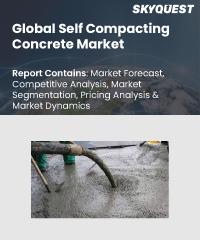
Report ID: SQMIG15F2049

Report ID:
SQMIG15F2049 |
Region:
Global |
Published Date: February, 2024
Pages:
157
|
Tables:
61 |
Figures:
75
Global Self Compacting Concrete Market size was valued at USD 11.46 billion in 2022 and is poised to grow from USD 12.15 billion in 2023 to USD 19.36 billion by 2031, growing at a CAGR of 6.0% during the forecast period (2024-2031).
The global self-compacting concrete market has witnessed substantial growth in recent years and is projected to continue its upward trajectory. Self-compacting concrete, also known as self-consolidating concrete, is a specialized type of concrete that has the ability to flow and fill complex forms without the need for external vibration. This unique property has gained significant traction across the construction industry, driving the market's expansion. The growth of the self-compacting concrete market is primarily attributed to several factors. Firstly, the increasing demand for high-performance concrete with enhanced workability and durability has fueled the adoption of self-compacting concrete in various construction applications. This includes residential, commercial, and infrastructure projects where the ease of placement and superior finish are highly desired.
Self-compacting concrete offers several advantages such as improved construction speed, reduced labor requirements, and enhanced structural integrity. These benefits contribute to time and cost savings during construction, making it an attractive option for contractors and builders. Moreover, stringent regulations and standards regarding sustainable construction practices have also propelled the demand for self-compacting concrete. The material's ability to reduce noise pollution, minimize environmental impact, and enhance energy efficiency aligns with the growing focus on green building initiatives worldwide. However, the global self-compacting concrete market faces certain challenges. One of the key challenges is the higher cost of self-compacting concrete compared to conventional concrete. The specialized materials and admixtures required to achieve the desired properties increase the overall cost of construction projects. This cost factor may limit the widespread adoption of self-compacting concrete, particularly in price-sensitive markets. Another challenge is the limited awareness and knowledge about self-compacting concrete among construction professionals. The proper understanding of mix design, placing, and curing techniques is crucial for achieving the desired performance and avoiding potential issues. Therefore, industry education and training initiatives are vital to overcome this challenge and promote the broader utilization of self-compacting concrete. Furthermore, the availability of raw materials and quality control of self-compacting concrete can pose challenges in some regions. Sourcing the necessary ingredients and ensuring consistent quality can impact the market's growth and hinder its widespread adoption.
US Self Compacting Concrete Market is poised to grow at a sustainable CAGR for the next forecast year.
Our industry expert will work with you to provide you with customized data in a short amount of time.
REQUEST FREE CUSTOMIZATIONWant to customize this report? This report can be personalized according to your needs. Our analysts and industry experts will work directly with you to understand your requirements and provide you with customized data in a short amount of time. We offer $1000 worth of FREE customization at the time of purchase.

Report ID: SQMIG15F2049